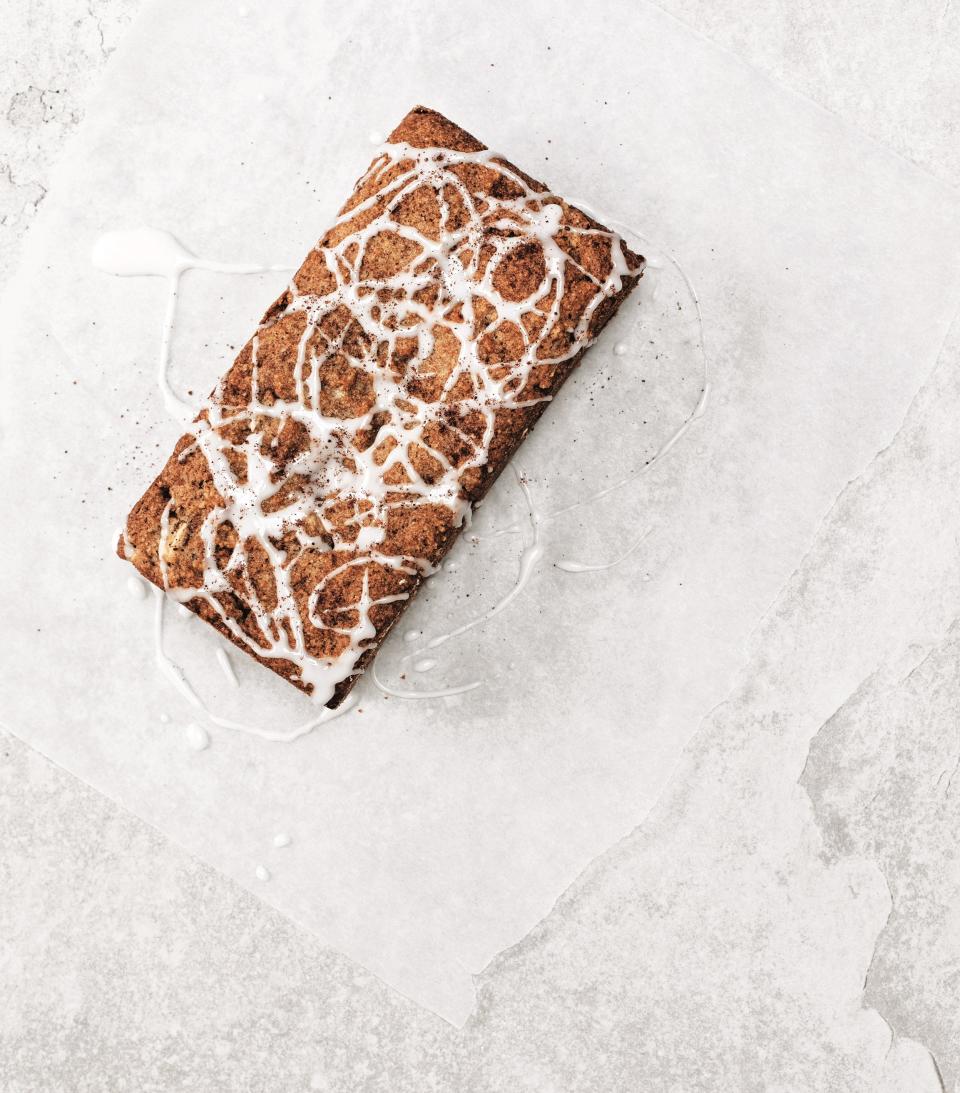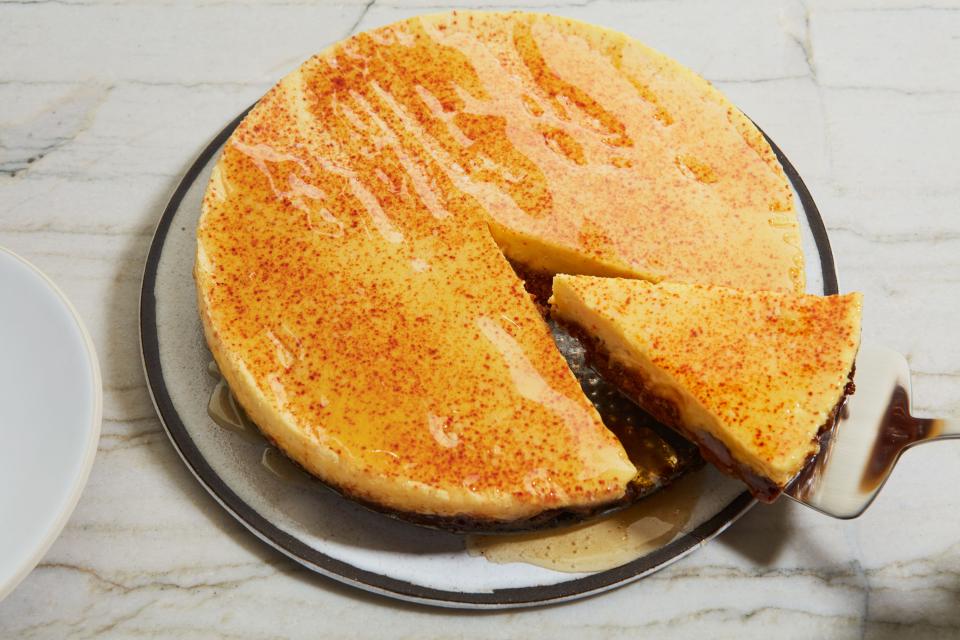Raid the Spice Cabinet to Make Your Sweets More Savory (and More Delicious)
A few months ago, when the Epicurious team was planning a package about spices, I pitched a story about the shift in sweet baking toward savory flavors—the ones usually reserved for main course duty—to create a new class of pastries and desserts. Maybe you remember seeing them at your favorite local bakery: items like black pepper financiers, smoked paprika sugar cookies, and togarashi cheesecake. They were fresh treats for the modern sweet tooth, and I hoped with the right recipes and a little encouragement, they’d illustrate exactly the kind of leveling-up that an avid home baker might want to tackle. The leave-it-to-the-professionals types could still participate by sampling the flavors out in the world, picking up a sweet-savory kouign amann or slice of spiced pound cake from a nearby shop.
Now, of course, everything has changed. In all likelihood, your favorite local bakery has had to temporarily close its doors. To fill the void (and also all the hours spent inside), everyone’s become an avid home baker; a few weeks in, we’re ready to stretch ourselves a little further than banana bread. Looking to pastry chefs and master bakers for inspiration feels more valuable than ever, and following their lead by integrating savory spices into our sweet baking projects checks all the right boxes: it’s a way to play with flavors that doesn’t require a dedicated shipping trip. That time you grabbed the garam masala from your pantry when you meant to get the cinnamon, catching yourself just in time before you scooped a teaspoon into your snickerdoodles? It turns out you might have been on to something really good.
Ingredients from outside the pastry station are tipping the scales for many new recipes back in the savory direction.
According to Melissa Weller, head baker at New York’s High Street on Hudson, the current pastry moment is marked by a pretty fundamental change in taste: people aren’t as enamored with sweetness as they used to be. After years ruled by softball-sized cupcakes under heaps of stiff buttercream, American sugar preferences have swung back the other way. Now, in reference to fancy restaurant desserts and homemade birthday cakes alike, we’re using “not too sweet” as the benchmark for a great bite. The rise in flaky sea salt as Ubiquitous Dessert Topper illustrates this well: “Ten years ago, it was very rare for anybody to sprinkle fleur de sel on their pastry,” Weller says. “Now everyone is putting it on their cookies—because we’re looking for balance.” To that end, ingredients from outside the pastry station have started to play a greater role in sweet baking, tipping the scales for many new recipes back in the savory direction.
The pursuit of a more balanced dessert has led many chefs to the spice cabinet, but Briana Holt, head baker at Tandem Coffee + Bakery in Portland, Maine, says “it’s not a conscious thing. I often come to a recipe from a backwards way, trying to achieve a certain vibe or feeling, rather than deciding I need to use a specific spice first.” For Holt, adding conventionally savory ingredients into her sweet baking arsenal gives her a lot more room to play, and many more opportunities to land on something new. Her process sounds a bit like ingredient matchmaking, pairing flavors that bring out the best in each other. “What can make the chocolate more chocolatey? What can give a dark and moody plum something heightened, to balance out the tartness and bring the flavor up?” The answer very well might be a spice from the same shelf as the baking heavy-hitters, but with a different skill set entirely: Chinese five spice, for example, instead of the classic pumpkin pie combo. Holt calls that “an exciting lateral move, a different room in the same house.”

Agatha Kulaga, cofounder of Ovenly in New York City, thinks that in addition to opening up space for chefs to be creative, the shift toward savory ingredients in sweet baking has practical implications as well. Unlike a towering slice of supersweet layer cake, she says, “Ovenly’s baked goods are meant to be a daily indulgence, treats that can actually be finished.” When a brownie has more going on than just chocolatey richness—like a bit of smoky heat from ancho chile powder—it’s compelling enough to keep eating, down to the very last crumb. Zachary Golper, chef and owner of Brooklyn’s Bien Cuit, agrees: To bring a sweet baked good into the “afternoon snack category,” he likes to pair acidic fruit with peppery or spicy flavors, making the final product just savory enough to keep the eater coming back. “People can only handle so much spice in a pound cake, for example,” he says. “But they do want that added flavor. It’s something different.”
Of course, using savory spices in sweet applications is as much about technique as it is ingredient choice. Chefs play with how and when they add the spice in question in order to deploy just the right amount, in a way that adds interest but doesn’t overwhelm. Weller is a fan of grinding spices with sugar to create a vibrant mixture, which she sprinkles between layers of her laminated kouign amann. Fruity and floral spices play well with the pastry’s abundance of butter and sweetness, so she gravitates toward flavors like saffron and pink peppercorn. Sasha Piligian, formerly of Nashville’s Lou and LA’s Sqirl, takes a similar approach, integrating coriander (as well as Meyer lemon) into the sugar for her flaky palmiers.

Savory Spice for Dessert - Cheesecake - HERO
Others go the infusion route, steeping whole spices in simple syrup, melted butter, or warm oil to imbue the liquid with savory flavor. At Tandem, Holt soaks a still-warm dark chocolate loaf cake in housemade juniper syrup, adding a “cool-in-temperature, forest floor vibe” that permeates every bite. You can steep whatever spice you want with the sugar and water, then use it to soak a loaf cake or brush a few cake layers,” she advises. “It’s a good way to get moisture into your cake in general, so the flavor is an added bonus.” Golper opts for infused fats at Bien Cuit, substituting all or part of the plain butter or oil that a recipe calls for with a punchy, spiced up version instead. Because the flavored fats can pack a wallop, he says, “controlling the dosage is very important.”
If integrating a savory spice into your next sweet baking project sounds like an exciting challenge, rest assured: anyone willing to stretch the idea of what counts as a dessert ingredient can tackle the trend at home. Piligian recommends playing with a simple, familiar recipe that adapts well to different flavors, like shortbread cookies. “Start with something you know you love and try adding one savory element, like a spiced sugar mixture,” she suggests. “Start small and work your way up to the flavor you want; you can always add more, but you can’t take the spice away!” Palmiers are a similarly versatile canvas for experimentation: spiking the sprinkling sugar with your favorite spice gets a savory note into each swirly layer. For every half cup of sugar, try mixing in a tablespoon of spice—the exact amount may vary depending on what spice you use, so taste a pinch and adjust until you strike the right balance.
"We’re not set in our ways, and we’re always evolving.”
To really taste the effects of savory spices, consider breaking out the ice cream maker; the high fat content and inherent richness of ice cream makes it a ready playground for savory flavors, so if you’ve been waiting for the right reason to dust your machine off, this is it. Tyler Malek of Salt & Straw, perhaps the king of ice cream flavor experimentation, agrees. “Ice cream carries flavors in ways that no other food can,” he says, “making it an interesting way to test out combinations.” He suggests pairing spicy or hot ingredients with fruitier ice creams (as in his strawberry, black pepper, and balsamic mash-up), while herbaceous flavors work better with chocolate or custard. Just don’t get discouraged if your first batch doesn’t come out as planned: “Spices can be intense and change as they freeze. We've had a thousand errors in R&D and a thousand instances of ‘happy accidents.’”

Palmiers - RECIPE
Like any tweak made to a time-tested form, using savory spices in baked goods and desserts isn’t an immediate hit with everyone; chefs have gotten used to giving customers a little nudge, and you may need to do the same with your quarantine-mates if you try out the trend at home. When the pastry case at Tandem is stocked with Chinese five spice apple scones and black pepper pear pie, Holt says, “We have to answer a lot of questions. People who are into food get it and want to try it, but there are plenty of people who say, ‘Is it spicy? Will it be good? Will I like it?’ There’s a learning curve.” At Lou, Piligian found that when people came in for dessert, “they expected a white cake with sugary frosting—traditional things with traditional flavors.” But, she adds, “The change is coming! When people are responsive to new combinations, it’s really exciting. They just didn’t know that was a possibility.” Holt agrees: “I love when I get to try something that I’ve never had or didn't expect, so helping other people have that experience is awesome.”
It may seem like a small thing, this change in how we think about dessert, but Weller believes that embracing variety and unusual flavor combinations is a uniquely American development. “In this country,” she says, “baking tends to be a little more creative. We’re not set in our ways, and we’re always evolving.” Maybe this means ten years from now we’ll be back on the toothache-inducing pastry tip again, clamoring for supersweet frosted cakes and cookies. In the meantime, however, while we’re cooking for ourselves at home, the savory wave feels like a perfect one to ride: a simple way to beat baking boredom, add a twist to an old standby recipe, or branch out in a completely new direction. As Holt says, it’s a worthwhile experiment, and one that you can take on today: “Most people already have everything that they’d need to try something different—right in their spice cupboards.”

How to support staff members at the bakeries and restaurants mentioned in this piece:
At High Street on Hudson, 100% of all gift card sales go to paying the hourly staff.
Support Tandem Coffee + Bakery by shopping online, including for Holt’s “Beneficial Biscuits,” which directly benefit the staff.
Donate to the Ovenly Employee Fund, which supports laid-off team members.
Order from Bien Cuit online for contactless delivery in Brooklyn and Manhattan, or contact-free in-store pickup.
Salt & Straw scoop shops are closed, but you can still order pints, gift cards, and merch on their website.
To support Lou, donate to the Tennessee Action for Hospitality “A Fund For Us,” which supports individual hospitality professionals who plan to continue their career in Tennessee when this crisis is over.
All proceeds from website sales of Jessica Koslow’s cookbook, Everything I Want to Eat, go directly to Sqirl’s hourly workers. Or donate to the Lee Initiative, which offers meals to any restaurant worker who has been laid off or seen a significant reduction in hours or pay.
Originally Appeared on Epicurious

